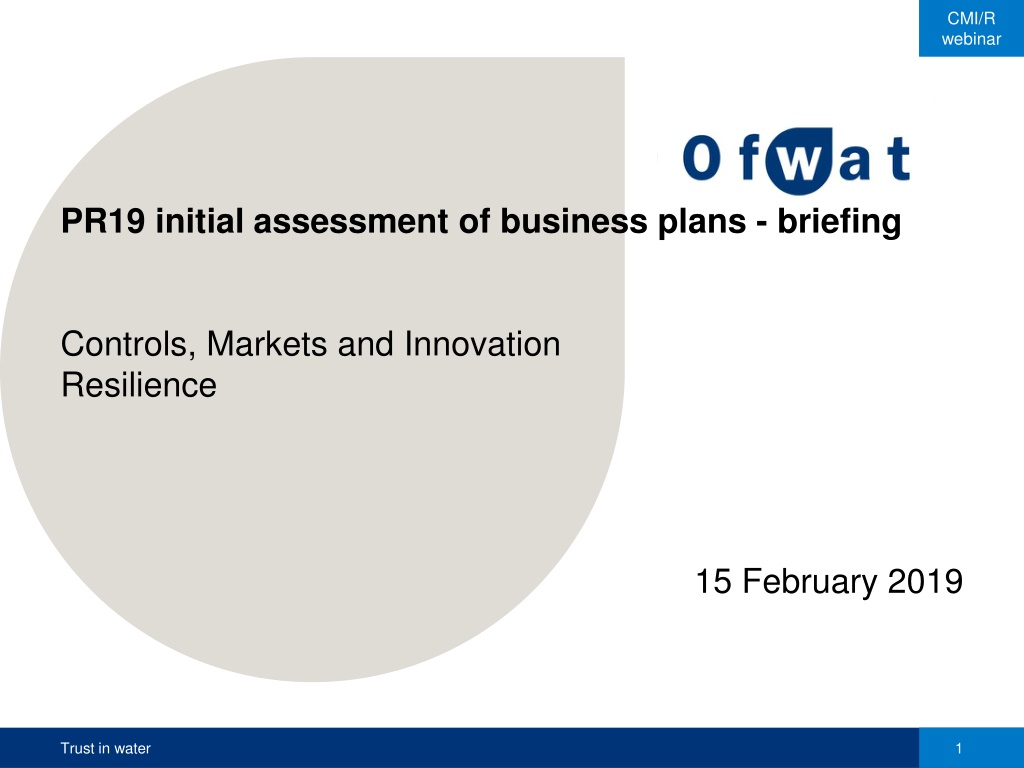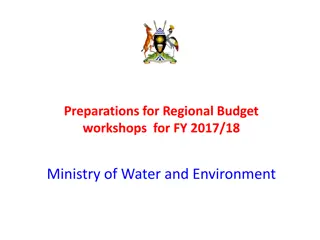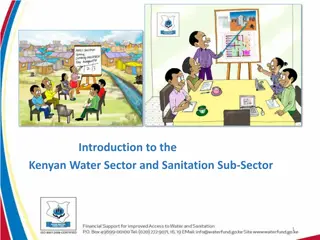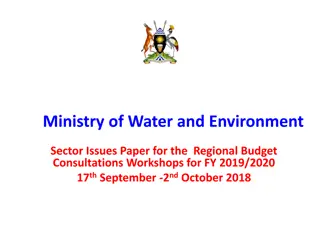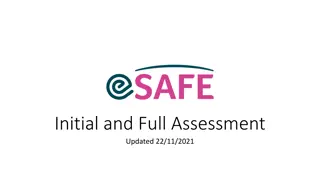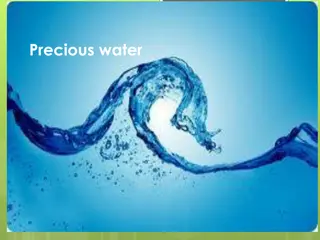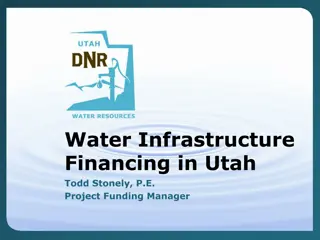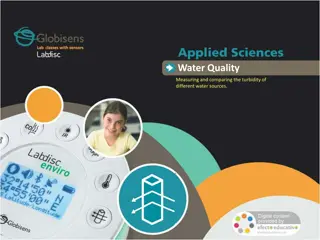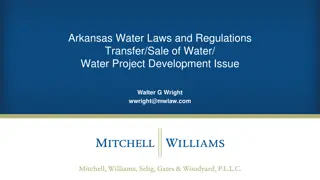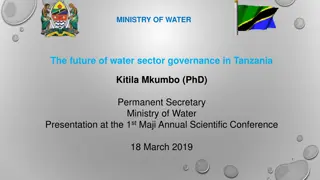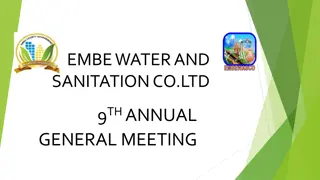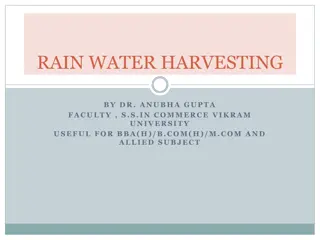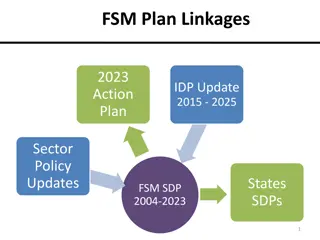Initial Assessment of Business Plans for Water Sector Development
This briefing outlines the key areas covered in the initial assessment of business plans for the water sector, focusing on Controls, Markets, Innovation, Resilience, and Trust. The webinar discusses the objectives, actions required from companies to meet quality standards, and the importance of addressing customer engagement, affordability, and vulnerability in long-term planning. The session aims to provide clarity on expectations from companies and ensure alignment with PR19 goals for sustained sector development.
Download Presentation

Please find below an Image/Link to download the presentation.
The content on the website is provided AS IS for your information and personal use only. It may not be sold, licensed, or shared on other websites without obtaining consent from the author. Download presentation by click this link. If you encounter any issues during the download, it is possible that the publisher has removed the file from their server.
E N D
Presentation Transcript
CMI/R webinar PR19 initial assessment of business plans - briefing Controls, Markets and Innovation Resilience 15 February 2019 Trust in water 1
CMI/R webinar Agenda and indicative timings Introduction Introduction 1 pm Controls, Markets and Innovation Controls, Markets and Innovation Q&A Q&A 1.10 pm Resilience Resilience Q&A Q&A 2 pm Trust in water 2
CMI/R webinar Initial assessment test areas Enhanced customer engagement; customer participation; engaging customers on long-term issues including resilience Engaging customers Addressing affordability and vulnerability Addressing affordability and vulnerability: affordability for all, now and in the long term, including those struggling to pay and services that are easy to access. Focus of today s session Delivering outcomes for customers Performance commitments, outcome delivery incentives, appropriateness of overall package Targeted controls, markets and innovation Innovation Use of markets Procurement Securing long-term resilience Resilience in the round ; risk identification and risk mitigation Securing cost efficiency Assessment of base and enhancement expenditure Cost adjustment claims Cost of capital, retail margins, risk assessment and mitigation, Use of PAYG/RCV run off levers Financeability Aligning risk and return Accounting for past delivery 2015-2020 reconciliation; confidence in business plans Securing confidence and assurance Board assurance, Putting the sector in balance, data quality Trust in water 3
CMI/R webinar Objective Today s meeting The objective of this webinar is to explain: our assessment overall the information we published, and what we are expecting next of companies. This will be focused on what is relevant to all or most companies, and will not be company-specific. The Initial Assessment of Business Plans covered nine areas. Today s webinar focusses on: Controls, Markets and Innovation. However, we will not discuss one element of this test area, i.e. Direct Procurement for Customers (DPC), because we have offered to meet companies on a bilateral basis. Resilience. Resilience is one of the key themes of PR19. Resilience in the round considers all aspects of resilience, including operational, corporate and financial resilience. Trust in water 4
CMI/R webinar Actions Actions include providing more evidence or clarification to substantiate part(s) of the business plan or reworking and/or resubmitting part(s) of the business plan because it falls short of the required quality. There are three types of actions. 1. Agreed actions that fast track companies committed to implement to ensure that their plans meet the threshold for fast track status. 2. Required actions for companies which in general are required so that we can make draft determinations (or final determinations for some aspects of past delivery). 3. Advised actions for companies to do by a specific date but that are not required for our draft determinations. Actions are set out in the action summary table and detailed actions documents. Trust in water 5
CMI/R webinar Timetable We will operate a queries process to assist development of revised business plans through pr19engagement@ofwat.gsi.gov.uk Next steps Companies submit information, including: completed business plan tables an actions tracker Draft determinations Respond to draft determinations Companies submit information, including: a revised business plan completed business plan tables a completed Ofwat financial model an actions tracker Draft determinations Respond to draft determinations All companies Final determinations Date 11 February 2019 Fast-track companies 11 April 2019 24 May 2019 1 April 2019 Slow-track and significant scrutiny companies 18 July 2019 30 August 2019 11 December 2019 Trust in water 6
CMI/R webinar Controls, Markets and Innovation (CMI) Trust in water 7
CMI/R webinar Why do we asses Controls, Markets and Innovation? Our approach to targeted controls, markets and innovation test area supports the four key themes of PR19. The test area includes three main components: innovation culture, markets and controls, and procurement. Innovation a culture of innovation helps companies to deliver long-term resilience, great customer service and affordable bills by delivering services in different and better ways; Markets and controls using markets, and developing new ones, allows companies to adopt new ideas and approaches to benefit customers, shareholders and the environment; and Procurement getting the right services in the right way helps companies to deliver the best outcomes for customers and the environment. Trust in water 8
CMI/R webinar Question 1 (innovation) How well does the company s business plan demonstrate that it has the right culture for innovation which enables it, through its systems, processes and people, to deliver results for customers and the environment from innovation? How did we assess companies? We assessed each companies culture of innovation by looking for evidence of our 14 drivers of innovation, grouped under three key areas: the right environment and space; the right leadership and support; and individuals can effectively work together. We graded companies highly where they provided good evidence for the majority of our drivers in each area. A company could only achieve the highest grade for this question if there was evidence that, in addition to having demonstrated the right culture for innovation in this question, it had also provided evidence of innovation and ambition in some of the other test areas. These were the areas of engaging customers, affordability and vulnerability, delivering outcomes, long term resilience, cost efficiency and controls, markets and innovation. Key to remember that this test area focusses on the evidence provided on innovation culture enablers Trust in water 9
CMI/R webinar Innovation: This covers an assessment of the companies culture of innovation (CMI1) United Utilities Test area Northumbrian Thames Water Wessex Water Anglian Water Severn Trent Affinity Water South Staffs Bristol Water Portsmouth South West Welsh Water South East Yorkshire SES Water Southern Dyfrdwy Hafren Water Water Water Water Water Water Water Water Water CMI1 A B B B B B B C C C C C C C C D D GENERAL OBSERVATIONS Main points from IAP assessment: While there are some examples of best practice and sector leading approaches, 10 companies have shown limited or no evidence of having a culture of innovation. There has also been limited evidence of innovation in other areas of the IAP. In general companies presented satisfactory evidence of senior leadership commitment and support but didn t demonstrate how staff are given autonomy, engaged or incentivised. Evidence of risk tolerance is limited. Evidence focussed on reducing the risk of failure, rather than accepting a level of failure and learning from it. General observations: While it is encouraging that all companies discussed innovation, many companies described processes and schemes which should improve the culture and capacity of innovation but which are not yet in place or are very new. There is little evidence of collaboration across companies on common innovation goals, and investment appears fragmented. The sector may benefit from greater collaboration on common goals and themes. There is limited evidence of innovative ideas across the rest of the IAP (despite some stretching cost efficiency and performance outcome targets). Trust in water 10
CMI/R webinar Question 2 (markets): How well does the company use and engage with markets to deliver greater efficiency and innovation, and to enhance resilience in the provision of wholesale and retail water and wastewater services to secure value for customers, the environment and the wider economy; and to support ambitious performance for the 2020-25 period and over the longer term? How did we assess companies? We assess four areas related to the use of markets: identification and management of gap sites and voids to ensure customers bills are fair; learning lessons and adopting innovation from the business retail market to help improve companies activities that are non-contestable; and use of markets, catchment management (preventing pollution from getting into raw water sources rather than, for example, treating the water after contamination) and partnership working for both wastewater and water network plus to benefit customers and the environment. We grade companies highly when they addressed all of these areas well. We consider matters related to water resources markets and bioresources markets under questions 3 and 4 respectively. Trust in water 11
Markets: This covers i) management of gap sites and voids, ii) learning lessons from the business retail market, and use of markets, catchment management and partnership working for iii) wastewater and iv) water network-plus CMI/R webinar Test area UUW WSH SWB WSX SEW AFW HDD ANH SRN TMS YKY SSC NES BRL PRT SVE SES Grade for this question B B B B B B C C C C C C C C C D D General observations Gap sites and voids We asked companies to explain how they would identify and manage their gap sites and voids. If these are not properly managed some customers will pay too little, meaning other customers will need to pay more to make up the shortfall. There was a range of performance from companies. Learning from the business retail market We assessed companies on what they had learned from observing the new market and whether they planned to apply this to their non-contestable activities. Wastewater and water network-plus For wastewater, companies generally provided high quality plans. Plans included strong integrated natural capital approach and robust assessments for sustainable drainage solutions. For water, some companies provided good evidence related to their use of En-trade for auction and payment purposes. A B C D Trust in water 12
CMI/R webinar Question 3 (water resources): To what extent has the company set out a well evidenced long-term strategy for securing resilient and sustainable water resources, considering a twin-track approach of supply-side and demand-side options and integrating third party options where appropriate, to meet the needs of customers and the environment in the 2020-25 period and over the longer term? How did we assess companies? We assess four areas related to water resources: engaging with third parties, including a collaborative approach to developing new supply and demand water resources solutions; appropriate water resources management plans (WRMPs) and the consistency with which this is reflected in companies business plans; facilitating and preparing for a potential future bilateral market in England, which will allow business retailers to procure water resources directly from third parties; and where relevant, proposed risk sharing arrangements for large new water resources investments (for example, storage reservoirs and desalination plants) to ensure customers are protected. We grade companies highly when they address these areas well. Trust in water 13
Water resources: We assess the extent that companies set out a well evidenced long-term strategy for securing resilient and sustainable water resources, with a clear twin track approach and integrating third party options where appropriate, to meet the needs of customers and the environment in the 2020-25 period and over the longer term? We also assess, where appropriate, companies proposed long term risk sharing arrangements for large new water resources . CMI/R webinar UUW WSH SWB WSX SEW AFW HDD ANH SRN TMS YKY SSC NES BRL PRT SVE SES Company A B B B B B B B C C C C C C D D D Grade for this question General observations The quality of the long term strategy for water resources is mixed across the companies, including limited evidence to support long-term approaches to water efficiency and future leakage ambition. When using markets, supply options are more prevalent than demand options. There are no new trades in the next period 2020-25. Some trades are planned to happen after 2025. Some companies have engaged with potential trading partners but to varying levels. The bilateral market (where third parties can sell water directly to business retailers in England) was appropriately addressed by many companies, as many plans have not sufficiently assessed the impact that entry might have on their approach. Long-term risk sharing arrangements are only relevant for a small portion of companies. In these few cases, companies did not appropriately address this area. A B C D Trust in water 14
CMI/R webinar Question 4 (bioresources): To what extent does the company have a well evidenced long-term strategy for delivering bioresources services, integrating an assessment of the value from the delivery of bioresources services by third parties for the 2020-25 period and over the longer term? How did we assess companies? We assess companies business plans to consider the robustness of the data that underpins their bioesources strategy and how well companies had explored trading and other market approaches in developing their strategy for bioresources services. Specifically, we assess: the extent to which companies show evidence of measurement of sludge and how they forecast sludge volumes; the extent to which companies show evidence of an appropriate split between fixed and variable revenue; the quality of companies bioresources strategies; the extent to which companies use appointed assets for non-appointed business and how the benefits would be shared with customers; and the extent to which companies consider the use of third-party suppliers and what preparation is in place for this. We grade companies highly where they address issues related to both market strategy and data robustness. Trust in water 15
Bioresources: There were two broad elements to the assessment: data and markets. Some companies did better on the data assessment, while others were stronger in the market assessment CMI/R webinar UUW SWB WSH WSX ANH SRN TMS YKY NES SVE Company Grade for this question B C C C C C C C C C General observations Main points for IAP assessment We assessed 10 companies. HDD was not evaluated as it produces a de minimis volume, all of which is exported for treatment. Only one company, Yorkshire Water had a plan that demonstrated aspects of high quality across both market strategy and data robustness. Common themes Many companies are considering the use of third parties for high-value services. Some ambitious plans to utilise markets with projects equating up to 4% of total sludge production. The level of detail on approaches to third-party engagement was limited in most cases. How profits from the use of appointed assets for non-appointed business will be shared with customers was generally missing. General lack of consideration of risks of using appointed assets for non-appointed business or risks from use of third party services. The level of trading is variable across companies, with short term resilience trades more common and longer term trades still at early stages of exploration. Some plans give the impression that there will be significant volumes already being traded, but the forecasts do not demonstrate this. Approaches put forward to achieve efficiencies were mostly those that one would expect to be part of a well functioning asset management process. Mixed evidence regarding forecast sludge production. Poor evidence on the split of fixed and variable costs. Detail on approach to measurement is poor for most companies. A B C D Trust in water 16
CMI/R webinar Question 5 (regulatory capital value, RCV): How appropriate is the company s proposed pre-2020 RCV allocation between water resources and water network plus, and between bioresources and wastewater network plus taking into account the guidance and/or feedback we have provided? How did we assess companies? Moving to four separate wholesale controls aims to promote markets and deliver value to customers. To do this, companies need to allocate the existing asset bases (or RCV) between the new separate controls. In 2017 we engaged with the sector and published guidance for companies regarding these allocations. In early 2018 we assessed companies proposed allocations and published our feedback. The initial assessment of business plans focuses on how companies addressed our feedback in their business plans. Trust in water 17
CMI/R webinar Webinar RCV This covers companies the appropriateness of proposals for allocating pre- 2020 RCV to separate controls CMI/R SWB WSH WSX SEW AFW HDD ANH SRN TMS SSC YKY NES BRL PRT SVE SES UU Company B B B B B B B B B B B B B B B C C Grade for this question General observations Overall 15 companies responded positively to our feedback the business plan allocations appear appropriate. Where Grade B was awarded where no further issues have been identified in our IAP review at this stage. Grade C was awarded where further justification was needed and/or where issues were identified with the process the company had followed given earlier feedback. For most companies there is no follow up action is required. Only one company has an action and this is already being progressed. We will check the allocations at DD and FD and ensure no material changes have been made. A B C D Trust in water 18
CMI/R webinar Question 6 (bid assessment framework): To what extent has the company produced a company bid assessment framework for water resources, demand management and leakage services that has demonstrated a clear commitment to the key procurement principles of transparency, equality/non-discrimination and proportionality, and the best practice recommendations? How did we assess companies? As part of transparency, we assess whether companies proposed processes for third parties to submit bids to supply services are clearly explained. This includes assessing whether the level of detail in the specification is sufficient, and whether there are opportunities for third parties to receive feedback following a bid. The principle of equal treatment is designed to provide confidence to third party bidders that their bids will be assessed fairly. This assesses whether an in-house proposed solution from the incumbent water supplier, is evaluated with the same criteria for both the in-house solution and the third party bid(s). The company s process must also ensure confidentiality and protect any commercially sensitive data provided by third parties. To assess whether the principle of proportionality is met, we assess whether the bid specification detail is designed to achieve the above effects and provides value for money for customers. We grade companies highly when they address all the relevant criteria. The maximum grade possible for this question is a B because it concerns compliance with procurement principles and applicable legislation, and so does not require innovation or ambition. Trust in water 19
CMI/R webinar Bid Assessment Framework (BAF) UUW SWB WSH WSX SEW AFW HDD ANH SRN TMS SSC YKY NES BRL PRT SES SVE Company B B B B B C C C C C C C C C D D D Grade for this question GENERAL OBSERVATIONS 1. The bid assessment framework is to support bidding market for water resources, demand management and leakage services, allowing third parties to submit bids to help the incumbent meets its future water needs. 2. There is significant variation in the amount of detail parties provide in their BAFs. 3. Some companies provided insufficient consideration regarding how they might handle commercially sensitive information. 4. The Utilities Contract Regulation (UCR) is frequently cited, with many firms indicating that they intend to extend their approach to complying with the UCR to cover bids that would not be captured by the UCR. A B C D Trust in water 20
CMI/R webinar Summary of our assessment A company s overall grade in this test area reflects the grades they achieved across the seven component questions, using appropriate weightings. UUW SWB WSH SEW AFW HDD TMS SRN ANH Test area SSC NES BRL SES PRT WSX YKY SVE Overall B B B B B C C C C C C C C C C C C 1. Innovation A C B B C B C B B C D C C B C C D 2. Markets B C B C B B C B C C C C C C D B D 3. Water resources B B B B B B A C C C B C C D C D D 4. Bio-resources C B C C C C C C C C 5. RCV allocation C B B B B B B B B B B C B B B B B 6. BAF B B C C C D B C C C D B D C C C B 7. DPC B D C C C C C C D C C C C D D D D Trust in water 21
CMI/R webinar Actions / key messages Companies should continue to explore and facilitate markets. We expect to see resource trading and collaborative delivery models to address future challenges. Common actions relate to aspects needed to make determinations on the bioresources average revenue control: The split of fixed and variable revenues to enable the average revenue control adjustment, and in some cases further evidence to support volume forecasts. The aim to ensure a degree of consistency Or forward looking actions: Drainage and Wastewater Management Plans where we need to ensure that WaSC can produce robust plans ahead of PR24; Updating water resource bid assessment frameworks Collaboration on innovation; There are other actions that we can discuss separately with companies on a bilateral basis. Trust in water 22
CMI/R webinar Resilience Question LR1: How well has the company used the best available evidence to objectively assess and prioritise the diverse range of risks and consequences of disruptions to its systems and services, and engaged effectively with customers on its assessment of these risks and consequences? Question LR2: How well has the company objectively assessed the full range of mitigation options and selected the solutions that represent the best value for money over the long term, and have support from customers? Trust in water 23
What we expected in our assessment of resilience CMI/R webinar Our resilience assessment draws on the expectations set out in the PR19 methodology and the framework set out in our Resilience in the round publication. IAP looked a many different facets within the context of resilience in the round , but for ease of presentation we have grouped elements in themes. The 1st resilience question (LR1) evaluates a broad range of elements, including: How companies have identified and assessed a wide range of risks to their resilience; Evidence of a systems-based approach that supports understanding of operational, financial and corporate risks and their interdependencies; Evidence of a quality assessment that incorporates quantitative and qualitative tools, collaboration with other parties and best practice; Company sfinancial scenarios to test whether companies can continue to access the financial resources they need under adverse financial circumstances relevant to the business; Corporate risk systems embedded in the oversight and decision-making processes of the company, includinguse of data for the identification and assessment of risks and monitoring of strategies and actions. The 2nd resilience question (LR2) looks at a range of financial, corporate and operational measures including: The full range of mitigation options considered that cover conventional, nature- based and behavioural change solutions; The extent to which each company's plan addresses the resilience risks they identify and whether this is supported by outcomes which reflect customer priorities; Financial mitigations: evaluation of resilience of capital structures, gearing levels and credit rating outlooks; Corporate mitigation systems embedded in the oversight of the company and assurance that processes, structures and governance are in place to avoid risks to resilience in the future. Trust in water 24
What we found in our assessment of resilience CMI/R webinar In In- -the the- -round Plans lack a systems-based approach Assessment of resilience maturity (baseline) not generally part of an applied framework. Consideration of a long list of hazards, but unclear prioritisation Operational resilience Operational resilience Limited quantification of risks, customer exposure and residual risk after existing mitigations. Limited consideration of wastewater and drainage challenges Environmental resilience and natural capital valuation thinking in their infancy Customers have been engaged on resilience, although in varying depth Financial Resilience Financial Resilience Stronger plans have clear board statements on financial resilience, assess financial resilience by reference to company s own internal risk assessment and clear evidence of risk management / risk mitigation measures Weaker plans lack detail on stress test results and relevant mitigation and/or fail to provide assurance around constrained ratios Corporate Resilience Corporate Resilience Well-established set of systems and processes to identify and assess risks individually. Limited or high level consideration of risk to delivery of the plan. round Risk identification - LR1 In In- -the the- -round Unclear line of sight between prioritised risks, mitigation options and improved outcomes Operational resilience Operational resilience Full range of options considered, but with less regard to emergency and response solutions Making an effort to engage with customers on options Limited use of nature-based solutions beyond typical catchment management schemes. Partnerships to develop efficient (multi risk) options need greater consideration Bespoke resilience PCs do not generally reflect companies approach to resilience and/or asset management strategy Financial Resilience Financial Resilience Strong plans project gearing and ratios consistent with comfortable investment grade ratings and set out prudent financing policies. While some of the stronger plans have not assessed financial resilience beyond 2025, we assign less weight to this in the overall assessment Weaker plans do not give assurance on access to finance or fail to address business specific risks Corporate Resilience Corporate Resilience Some corporate mitigations discussed at high level with unclear commitments round Risk mitigation - LR2 Trust in water 25
Financial resilience Andrew Chesworth Trust in water 26
Financial Resilience What we were looking for CMI/R webinar Expectations for financial resilience for business plans were clarified in our putting the sector in balance position statement Building on the requirements of long term viability statements, we expected companies to model their own scenarios and to be transparent about the impacts on their long term financial resilience for the period 2020-25 and beyond In addition, we set out a suite of prescribed scenarios that we expected companies to present. We looked for evidence in the commentary in relation to: financial/corporate structures and refinancing requirements, including for different tranches of debt; headroom on credit ratings and key financial ratios; and evidence supporting the steps companies said they would or could take in scenarios where financial resilience is at risk. Additional scrutiny where heightened risks exist due to: Target credit rating one notch above minimum for investment grade Gearing levels proposed to be maintained above 70% threshold for triggering the gearing outperformance mechanism Limited headroom in key financial ratios Significant refinancing requirements or other company specific risk factors Trust in water 27
Financial Resilience What we found CMI/R webinar Companies took a variety of approaches in their assessment of financial resilience; pleased to see that most build on long term viability statements in the Annual Performance Reports Most companies presented impacts on key financial ratios, though there was a variety of approaches Best plans contained: Clear board statements about financial resilience Assessed financial resilience by reference to own internal risk register Present clear evidence of risk management and mitigation measures However Some plans did not set out stress test results as key financial ratios. Several companies failed to consider financial resilience beyond 2025, despite holding a licence that ensures beyond 2025. Some concerns that some companies did not discuss company specific risk factors eg debt refinancing / financing requirements, company specific cost of capital claims, impacts of gearing outperformance mechanism Some instances where focus is on covenant requirements, not taking account of other risk indicators. One company provided no evidence of its financial resilience assessment at all, which contributed to a D score We do not necessarily have concerns about the financial viability of companies with plans assessed as weaker in this area. It is however, important that companies providing an essential service to customers can demonstrate that they are resilient to the impact of financial shocks on an ongoing basis. We are taking forward learnings from the IAP assessment to inform guidance for company Long Term Viability Statements for this years Annual Performance Report Trust in water 28
CMI/R webinar Securing long term resilience: Overall assessment Trust in water 29
IAP test question grading CMI/R webinar Water and sewerage companies Water only companies Question Question Northumbrian Water Severn Trent Water South Staffs Water Portsmouth Water South West Water South East Water Yorkshire Water Anglian Water Southern Water Hafren Dyfrdwy United Utilities Thames Water Wessex Water Affinity Water Bristol Water D r Cymru SES Water C Resilience test area C C D C C B D D B C D C C C D C Question 1 B C C D C C B D C B C C C C C D C Question 2 C C B C C C B C D B C D C C C C C Strong evidence of risk identification and mitigation points to, but does not assure resilience. Conversely, poor evidence may belie effective controls. The IAP enables a ranking of companies according to evidence of identifying and mitigating resilience risks not their resilience performance today, or the scale of resilience improvement planned. Trust in water 30
Actions / key messages CMI/R webinar Overall, plans demonstrated high quality aspects of corporate, financial and operational resilience but not resilience in the round. We are looking for a clear embedded framework that is applied continuously and informs decision making. A common shortcoming was a lack of an integrated resilience framework to inform actions. High quality approach to financial, corporate and operational resilience on the whole was sufficient for a grade B, but even the best plans fell short of being able to evidence an integrated approach to resilience. Supporting evidence to demonstrate resilience often not clearly linked to the business plan, resilience risks or outcomes for customers. Limited consideration of asset health and lack of robust forward looking metrics is a gap. Resilience actions required of companies: Financial resilience specific actions for companies to respond to in their revised plans or the LTVS; Development of actions plans by 22 August to put in place a resilience framework consistent with delivering resilience in the round. Improvements will take time to deliver we would expect companies to be seeking improvements quickly. Lack of forward looking asset health metrics a key gap for demonstrating operational resilience. We are looking for the sector to develop proposals for metrics collectively. No firm deadline but we would like to see metrics developed, measurement and shadow reporting to inform business decisions and enable inclusion at PR24 (We will engage with companies on delivery but probably no later than end 2021) Trust in water 31
